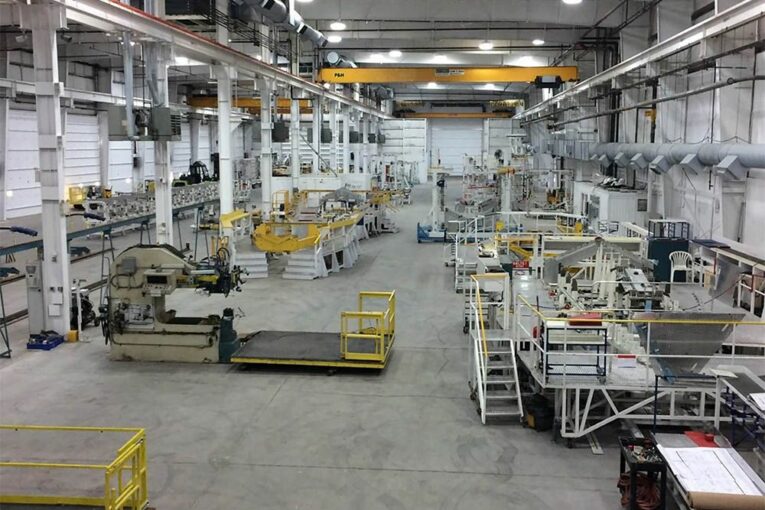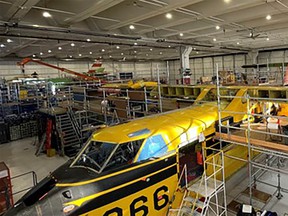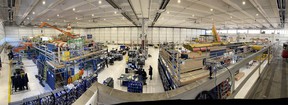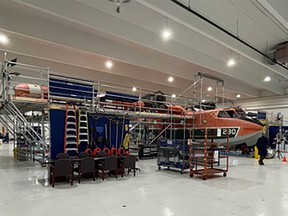
De Havilland Aircraft of Canada is shifting its head office to Calgary and taking a step forward with plans to build a new amphibious firefighting aircraft in the city.
The company, which operated as Viking Air in the city until February, announced last week that European Union countries have signed letters of intent to purchase the first 22 new aircraft, known as the DHC-515 Firefighter.
The plane is an upgraded version of the iconic Canadair CL-415 “Super Scooper” water bomber, used around the world to combat wildfires.
If country-to-country negotiations are finalized, De Havilland will hire workers for more than 500 local positions to assemble the aircraft, which is capable of refilling its tanks within a dozen seconds from nearby rivers, lakes or oceans, instead of having to return to an airport following a drop.
“We’ve been undertaking a significant review of supply chains, of the logistics of bringing the aircraft back into production, and we’ve made a decision to launch the program,” company spokesman Neil Sweeney said in an interview.
“We expect the first deliveries to be in early 2026 … We could be cutting metal as early as the end of this year, depending on what’s the timing of the contracts being signed.”
A sale of new planes to EU members must still involve negotiations between the countries and the Canadian Commercial Corp. (CCC), which is Canada’s government-to-government contracting organization.
The expected buyers of the planes weren’t named, although existing Super Scooper customers in Europe include Greece, Spain, France, Italy and Croatia.
“This is very significant news for Alberta and for the aerospace sector in our province,” said Calgary-based industry analyst Rick Erickson.
“These are very high paying jobs, highly skilled, and there’s a very significant economic impact attached to that.”

De Havilland already has about 200 employees and it operates out of several buildings in the city with more than 530,000 square feet of space at or near the Calgary airport.
It currently refurbishes and provides parts and service to the older CL-215 and CL-415 firefighting aircraft, and manufactures an updated version of the classic Twin Otter aircraft in Calgary. It also has operations in Victoria and Toronto.
Moving ahead on assembling a new, upgraded amphibious water bomber — something it has been working on for years — would require hiring hundreds of positions in the city and lead to more collaboration with post-secondary institutions, such as SAIT.
“To bring an aircraft into production, you need all kinds of skills, whether it be aircraft mechanical engineers, project managers, people in finance,” Sweeney said.
“There are not enough employees to fill the 500 roles but … it’s going to take two or three years before we get up to full production, so we do have some time.”
The announcement was made as the city and province have been striving to turbocharge growth in the aviation and aerospace sectors.
Before the COVID-19 pandemic, the aviation industry contributed about $1.5 billion annually to the Alberta economy, although that figure dropped below $500 million in 2020 as the industry was hammered by COVID-19 travel restrictions.
The sector employs about 10,000 Albertans, according to provincial data.
With two international airports and the presence of Edmonton-based Flair Airlines and WestJet and Lynx Air being headquartered in Calgary, the broader aviation sector has the potential to grow in the province, say experts.

Last year, the province formed a new Strategic Aviation Advisory Council to examine ways to expand the industry.
Council chair Richard Gotfried said the province will have the ability to boost exports and sell technology to other countries with the DHC-515 Firefighter program lifting off.
“It’s a catalyst and a vision for the future because where you bring one, you bring more,” said Gotfried, who is the MLA for Calgary-Fish Creek.
De Havilland is also in the process of shifting its head office to Calgary from Toronto as the company amalgamates its various operations.
Longview Aviation Capital bought the De Havilland Dash 8-400 program from Bombardier about three years ago.
In February, Longview announced the consolidation of Viking Air, Longview Aviation, Pacific Sky Training and De Havilland Canada under the operating brand, De Havilland Aircraft of Canada. The private company is owned by Westerkirk Capital, which is owned by billionaire Sherry Brydson.
A new CEO of De Havilland Canada, Brian Chafe, was recently appointed and he will work out of Calgary.
When Longview purchased the Dash 8 program, Bombardier had already decided to sell the Downsville plant in Toronto to a developer, Sweeney noted.
“We have been looking for a new home and obviously Calgary makes perfect sense, given our breadth of operation here,” he said.
“Engineering and some other support functions will remain in Toronto, but with production moving here, everything to do with production will be based in Calgary.”

The company is also considering the future of the Dash 8 aircraft after De Havilland announced last year a pause in the production of new Dash 8-400 at the Downsview plant.
Sweeney said De Havilland has every intention of bringing the aircraft back into production, although market forces will determine its future. Calgary is a “strong contender” to produce the Dash 8, but no decision has been, he said.
Calgary Economic Development vice-president of business development Patrick Mattern noted aviation is one of several key sectors the city is looking to aggressively pursue.
Attracting a well-known corporate name like De Havilland — with roots in manufacturing aircraft in Canada that date back to 1928 — can open up other doors, such as attracting new suppliers to become part of the local supply chain, he said.
“It opens the eyes of people that there’s more going on in the city than they expect,” Mattern said.
“It’s a recognizable name right off the start and having that associated with Calgary, that’s gold for us.”
Chris Varcoe is a Calgary Herald columnist.
You can read more of the news on source
